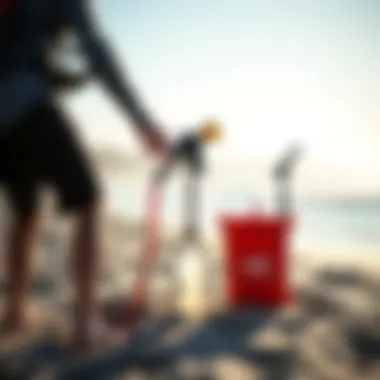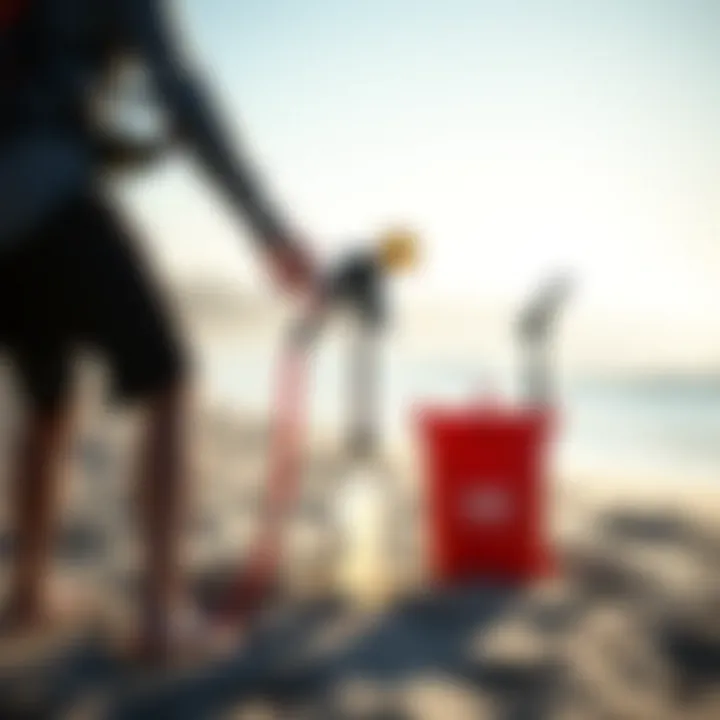The Practical Benefits of Portable Rinse Kits for Watersports


Intro
For those diving into the exciting world of watersports, the experience can often be as liberating as it is exhilarating. Yet, with great fun often comes the need for proper hygiene and maintenance in the aftermath of a fun-filled day in the water. Enter the portable rinse kit: an unsung hero for many enthusiasts who take watersports seriously.
With options available that cater to the various nuances of each sport, from kayaking to windsurfing, these kits are invaluable allies in keeping gear and skin free from the troublesome residues that saltwater, sand, and algae can leave behind. In this guide, we’ll explore why having a portable rinse kit is not just a luxury but a necessity for maintaining optimal performance, ensuring safety, and prolonging the life of your equipment.
This journey will dissect essential features to look for when selecting a rinse kit, the advantages they provide, and a close look at specific products that rise above in the marketplace. We will also get our hands dirty (figuratively!) discussing maintenance tips to keep your rinse kit in top working condition.
Through this article, avid watersport participants, coaches, and casual recreationists can gain valuable insights that help elevate their on-water experience. So, let’s paddle through the depths of portable rinse kits.
Foreword to Portable Rinse Kits
When it comes to watersport activities, staying clean can often take a back seat to the thrill of the ride. Yet, the importance of maintaining your gear and your own cleanliness cannot be overstated. This holds especially true when engaging in activities such as kayaking, paddleboarding, or surfing, where salt, sand, and other elements can lead to wear and tear on equipment and discomfort for participants. Enter portable rinse kits—a practical solution that allows athletes, coaches, and recreationists alike to wash off quickly after a day on the water, preserving not only the integrity of their gear but also enhancing their overall experience.
Portable rinse kits provide a straightforward means to address the mess that comes with various watersports. They typically consist of a container that holds fresh water, a nozzle for spraying, and often a few extras that cater to specific user preferences or needs. With sizes ranging from compact units designed for solo adventurers to larger setups meant for group outings, these kits are accessible no matter the activity level or setting.
Key Points of Discussion
- Importance of Cleanliness: Understanding why keeping gear clean is vital for longevity and performance.
- Features of Rinse Kits: Elements that make these kits effective and desirable for watersport enthusiasts.
- User Considerations: Maintenance tips and suggestions for optimizing usage across different sports.
By breaking down the fundamental components of portable rinse kits, this article aims to give readers insight into both their functionality and significance. For anyone who ever left the water wishing they had a quick way to rinse off, these kits can be a game-changer.
Defining Portable Rinse Kits
Portable rinse kits are simple yet effective tools designed for immediate access to fresh water. Unlike traditional shower setups or garden hoses, these kits are lightweight, compact, and easily transportable, making them ideal for a day at the beach, riverbank, or lake. The main components usually include a durable water container, appropriate nozzle attachments, and sometimes accessories such as a shower head or pressure chamber.
Key Features of Portable Rinse Kits
- Water Container: The heart of any rinse kit, which holds a specified amount of water—sometimes several gallons, depending on the model.
- Nozzle Options: Various attachments can change the flow of water from a gentle mist to a powerful stream, providing optimal rinsing options for different needs.
- Portability: Designed for ease of transport, often featuring comfortable handles or ergonomic designs for easy carrying.
Taking into account these features should clarify why portable rinse kits have surged in popularity among avid watersport participants. They offer a balance of convenience and necessity, especially after a fun but gritty day.
Historical Context of Rinsing Equipment
Rinsing equipment has evolved significantly over the decades. Historically, watersport enthusiasts relied on basic methods—like buckets or primitive hose setups adjacent to the water’s edge. Whether it was the local beach or an open lake, individuals often had to make do with the bare essentials.
With the advancement of materials and technology, portable rinse kits began to emerge as a specialty item in the watersport market. Early versions were often clunky and cumbersome. However, as technology progressed, manufacturers began to focus not just on the function but also on improving the design, portability, and efficiency of these kits.
As watersports gained popularity worldwide—thanks to the rise of beach culture and recreational activities—the market for rinse kits expanded too. Companies started to focus on innovative materials like lightweight plastics and durable fabrics that could withstand outdoor conditions. The kits became not only more reliable but also more stylish, catering to the aesthetics of modern sports enthusiasts.
In summary, the history of rinsing equipment reflects a broader narrative about the advancement of outdoor gear as a whole. An enhancement of user experience and satisfaction has fostered a market where portable rinse kits have found their rightful place as essential gear for anyone involved in watersports.
Key Components of a Portable Rinse Kit
When discussing portable rinse kits designed for watersport activities, understanding their key components becomes paramount. Each element is tailored to enhance the user experience, whether it’s after an intense surf session or a leisurely paddle in the lake. In this section, we will delve into three distinct components: water storage capacity, nozzle options, and the quality of materials used.
Water Storage Capacity
The water storage capacity of portable rinse kits plays a crucial role in determining their efficacy. A kit with ample storage means you won’t be left high and dry after a long day on the water. Typically, these kits can range from a modest 2-gallon tank to larger 5-gallon options. Having more water on hand allows you to rinse off not just gear, but also sand, salt, or mud from your body, which can be essential for comfort.
The broader the storage, the more comprehensive your clean-up can be, but it's essential to balance between capacity and portability. A kit that's too bulky can hinder mobility and become cumbersome. Thus, finding a goldilocks zone — one that provides enough water without being too heavy or unwieldy — is key.
"Choosing a rinse kit with the right water capacity is like picking the right size surfboard; too big or too small can lead to problems."
Nozzle Options for Versatility
Rinse kits come equipped with various nozzle options that cater to different cleaning needs. A multipurpose nozzle can switch between a fine mist, aimed for skin rinsing, to a powerful stream, which is ideal for gear and equipment. The versatility of the nozzle not only affects how effectively you can clean but also how water is conserved during the process.
For instance, utilizing a mist can save water while still refreshing you after a hot day. Conversely, a high-pressure stream can blast off stubborn sand stuck in your gear. Some models even allow users to customize or interchange nozzles based on personal preference or specific tasks, making for a highly adaptable cleaning experience.
Materials and Durability
Durability is an often-overlooked aspect of portable rinse kits. The materials used in the construction of these kits determine their lifespan and reliability. Many rinse kits are made from polyethylene, which is known for being lightweight yet sturdy. Other high-end models may employ tougher composites that can endure rough handling and exposure to elements without cracking or degrading.


A good rinse kit should also have seals that prevent leaks, which can be a deal-breaker during a trip. Look for units that have reinforced water connections, as flimsy parts can lead to frustrating leaks that leave you scrambling at the worst of times.
Choosing a rinse kit made from robust materials ensures that your investment lasts through many summers of fun-filled watersport activities. By focusing on these key components, you can make an informed decision when selecting the right rinse kit that will meet your specific needs for years to come.
Benefits of Using a Portable Rinse Kit
Portable rinse kits offer significant advantages for those who spend their time enjoying watersports. They serve multiple purposes and address various challenges faced by athletes, coaches, and recreational aquatic adventurers alike. Briefly, the benefits cover three primary areas: post-activity clean-up, convenience and mobility, and enhanced gear longevity. Each of these elements plays a vital role not just in maintaining hygiene but in improving the overall experience on the water.
Post-activity Clean-Up
After a day spent on the waves or lakes, the last thing you want is to lug around dirty gear that can host sand, salt, or other grime. Portable rinse kits make post-activity clean-up a breeze. With a quick spray after your activities, you can remove salt from surfing or dirt from kayaking before packing away your equipment.
By keeping your gear clean, you prevent residue build-up that can be tough to remove later and can cause wear and tear. An effective rinse makes sure you wrap up your day on the water feeling fresh, rather than carrying around unpleasant remnants of your adventure.
"Cleaning up isn’t just about hygiene; it’s about setting the stage for your next outing."
Convenience and Mobility
One of the standout features of portable rinse kits is their design prioritizing mobility. Many models come lightweight with ergonomic handles. You can easily carry a rinse kit to the beach or on a boat without it becoming a hassle.
Imagine this: you just finished a strenuous paddleboarding session and want to rinse off before heading home. With a portable rinse kit, you can achieve that quickly and efficiently.
The mobility factor extends to various activities as well.
- Compact Size: Fits into backpacks.
- Easy to Use: No extensive setup is required.
- Refillable Options: You can fill on the go, whether at a tap or a lakeside.
This convenience means you don’t need to waste time searching for a shower or worrying about clean-up. You simply have it all at your fingertips.
Enhanced Gear Longevity
Let’s face it – gear is not cheap. Whether it’s a high-end kayak or your favorite surfboard, protecting them should be a priority. Regular rinsing with a portable rinse kit significantly contributes to the longevity of your equipment.
Saltwater and dirt can cause corrosion, and exposure to the elements can wear out materials faster than you'd think.
- Material Integrity: Keeping equipment clean preserves the material integrity of your gear.
- Preventative Maintenance: Incorporating rinsing into your post-activity routine acts as preventive maintenance.
- Longer Lifespan: Ultimately, this leads to a longer lifespan for your aquatic gear, saving you dollars in replacements.
The need to keep your equipment functional and durable cannot be overstated. Investing in a portable rinse kit is investing in the longevity of your gear. Whether you're a casual weekend kayaker or a hardcore surfer, the benefits of having clean, properly maintained gear will always pay off in the long run.
Considerations for Maintenance
Taking care of a portable rinse kit is not just a matter of convenience; it's about preserving the integrity of your equipment and ensuring it lasts through multiple adventures on the water. Simple maintenance practices can extend the life of your portable rinse kit significantly. Given the often harsh environments where these kits are used—think sun, sand, and salt-water—paying attention to maintenance can mean the difference between a quick rinse and a frustrating, unusable gadget when you need it most.
Water Quality and Treatment
The quality of water used in your rinse kit is fundamental. Tap water may work fine, but if you’re grabbing fluids straight from a natural source, caution is warranted. It might sound overly cautious, but contaminants like bacteria, algae, or chemicals can wreak havoc not only on your rinse kit but also on your gear and skin. Using filtered or treated water ensures that your equipment remains in top shape.
- Rinse After Each Use: After every watersport activity, rinse out the tank to remove any residual debris. Even small particles can settle, creating a blockage over time.
- Use Water Treatment Options: Consider investing in portable water treatment options, like purification tablets or filters. This is particularly useful for those who often find themselves in remote areas with questionable water quality.
- Empty and Clean: At the end of a trip, drain any leftover water and give the tank a thorough cleaning. Some kits come with compatible cleaning solutions, or a simple vinegar solution can do wonders.
Regularly checking and treating water also helps in avoiding algae growth or any funky smells that could develop due to stagnation.
Storage Tips for Longevity
Storing your portable rinse kit properly can significantly enhance its lifespan. The way you store your kit largely determines how well it performs down the line. The following practices can lead to better maintenance and prolonged usability:
- Keep It Dry: Moist areas tend to breed mold and bacteria. Make sure the kit is thoroughly dry before packing it away. A dry environment ensures that the materials remain intact and functional for subsequent uses.
- Avoid Extreme Temperatures: When not in use, store your rinse kit away from direct sunlight or extreme temperature fluctuations. Storing it in a garage or shed might expose it to heat during summer or cold drafts in winter, which can degrade materials over time.
- Use Protective Covers: If available, use protective cases or covers designed for your rinse kit. These can shield against accidental drops or impacts, especially if you transport it frequently.
- Regular Inspections: Take a few minutes to inspect your kit before your next outing. Look for signs of wear and tear or any leaks. This habit can save you from unpleasant surprises while you’re out on the water.
"A stitch in time saves nine." Following these maintenance tips can effectively prevent future problems and ensure that your portable rinse kit remains a reliable companion on all your watersport endeavors.
By giving attention to maintenance details like water quality and proper storage, you can ensure that your rinse kit is always ready when you need it most, enhancing your overall experience on the water.
Comparative Analysis of Market Options
When it comes to selecting the right portable rinse kit, it can feel a bit like searching for a needle in a haystack. With numerous brands vying for attention, a comparative analysis helps you drill down to what’s important. Understanding the market options not only highlights the features that make each kit unique but can also reveal how they align with a user's specific needs. This section digs into some prominent brands, highlighting their characteristics while weighing their pros and cons. This will aid watersport enthusiasts in making an informed decision without getting bogged down by unnecessary details.


Brand A: Key Features and Advantages
Brand A has made quite the reputation for itself in the portable rinse kit market. With a water storage capacity of up to 5 gallons, this brand shines when it comes to functionality. One of the standout features is the pressurized spray nozzle, which delivers a strong, consistent stream of water suitable for rinsing off equipment and gear after a long day on the water. Added benefits include a durable construction that stands up to the wear and tear of outdoor use.
- Advantages:
- Large capacity ideal for multiple cleans.
- Easy-to-use pressure nozzle for effective rinsing.
- Sturdy materials ensure longevity.
In terms of reliability, Brand A often gets glowing reviews from users in various watersport disciplines, making this a well-rounded choice for anyone on the hunt for a portable rinse kit.
Brand B: Unique Selling Points
Brand B is known for its sleek design and compact structure. Unlike most competitors, this brand has focused on portability, making it an excellent choice for those who travel often with their gear. The integrated carry handle and lightweight feel means you can toss it in your car without thinking twice.
- Unique Selling Points:
- Compact size perfect for traveling.
- Innovative carry handle for easy transport.
- Affordable price point without compromising quality.
Users appreciate how easy it is to whip this kit out after a surf session or kayaking trip. The experience remains seamless and efficient thanks to its no-fuss approach.
Brand C: Value Proposition
Brand C stands out by catering to a niche market focused on eco-friendly options. Utilizing recycled materials for both the tank and nozzle, this brand appeals to environmentally conscious users. In addition, it features a filtration system that improves water quality, making it a responsible choice for rinsing off aquatic life.
- Value Proposition:
- Eco-friendly materials promote sustainability.
- Water filtration system elevates rinsing experience.
- Aligns with the ethos of many nature lovers.
People who prioritize sustainability over other aspects of design may find Brand C a compelling choice. Its commitment to the environment resonates well, especially among a growing audience who wish to protect the waters they enjoy.
"The right portable rinse kit can make all the difference in enjoying the clean-up process after a watersport activity."
By considering these brands—each with its distinctive features—potential buyers can better navigate the waters of choice that lay ahead. Make sure to weigh what's essential for you, whether it’s capacity, portability, or environmental impact.
Operational Challenges and Limitations
As practical as portable rinse kits may seem, they are not without their challenges and limitations. Understanding these concerns is vital for users who want to maximize their aquatic experience while ensuring proper maintenance and usability of their equipment. This section will delve into some of the key operational challenges these kits face, focusing on pressure limitations and temperature considerations.
Pressure Limitations
One of the first and foremost issues with portable rinse kits is the question of pressure. Most kits are designed with a certain water pressure in mind, which can greatly affect the effectiveness of rinsing off sand, salt, and other debris from watersports activities. Users often find that, when filled to the brim, the water pressure isn't strong enough to dislodge stubborn particles from their gear.
Imagine dragging your paddle board out of the waves only to find that the rinse kit delivers a mere dribble. That minimal pressure can leave you fighting a losing battle against grimy build-up, which nobody wants after a day out on the water. Here are some things to consider regarding pressure:
- Water Source: If you're relying on river or lake water, the pressure can significantly fluctuate based on the availability of bottled or pressurized sources.
- Nozzle Quality: The kind of nozzle you use can also impact how efficiently the rinse works. A high-quality nozzle can help to concentrate the spray and increase pressure, making cleaning easier.
- Tank Size: Smaller tanks will naturally limit pressure as well, affecting the rinsing efficiency.
Keep in mind: Always verify the specifications provided by the manufacturer regarding the operational pressure of the kit to avoid disappointment when the time comes to wash down.
Temperature Considerations
Temperature can be trickier than it sounds when it comes to portable rinse kits. Rinsing with water that's too cold can be counterproductive, especially when you're trying to clean off sticky substances like sunscreen or food remnants. Conversely, water that is too hot can damage sensitive gear or even cause the container to warp over time.
Here are a few elements worth pondering regarding temperature:
- Desired Water Temperature: To effectively rinse your equipment, aim for lukewarm water. This temperature tends to be most effective when you are scrubbing off tougher residues.
- Material Effects: Not every rinse kit is built to withstand extreme temperatures. Be sure to check if the materials used can handle hot water without compromising their integrity. For instance, plastic tanks can become softer in intense heat, leading to leaks or cracks.
- Seasonal Variations: Depending on where you are, temperature changes throughout the year may influence how you use your rinse kit. In colder months, you might want to consider water retention strategies to prevent freezing.
Overall, acknowledging these operational challenges can significantly improve the user experience with portable rinse kits. The right knowledge equips watersport enthusiasts to make informed decisions that will enhance their enjoyment and ensure their gear stays in great shape.
Compatibility with Different Watersports
The versatility of portable rinse kits shines when considering their compatibility across various watersports activities. Users often engage in diverse aquatic sports ranging from kayaking to scuba diving, each with its own unique requirements for equipment care and maintenance. Understanding these nuances can significantly enhance the overall experience for athletes and enthusiasts alike.
Kayaking and Canoeing


For those who navigate rivers or lakes in kayaks or canoes, the aftermath can often include mud, dirt, and algae clinging to gear. Here, portable rinse kits become essential tools in maintaining the integrity of your equipment.
- Ease of Cleaning: After a day on the water, simply spraying down your kayak or canoe can prevent build-up that might otherwise degrade materials over time.
- Quick Rinse: Rinse kits with adaptable nozzles make it easy to reach all the nooks and crannies of your craft, unlike bulky hoses or faucets directly from docks.
- Environmental Considerations: Using fresh water to rinse off gear helps preserve local ecosystems, minimizing the transfer of invasive species and pollutants from one water body to another.
"The best rinse kit is one that can reach the trickiest spots on my kayak; it's become my go-to gear after a day out on the water."
— A devoted kayaker's insight
Surfing and Paddleboarding
For surfers and paddleboarders, the sea’s saltwater can wreak havoc on gear. Salt not only affects plastics but can corrode metal parts as well. Thus, incorporating a rinse kit into your post-surf routine is vital.
- Saltwater Residue: A thorough rinse is essential for clearing salt residues which can otherwise lead to wear and tear. Rinse kits with sufficient flow can make light work of this chore.
- Convenience: Portable kits allow surfers to rinse off right at the beach, saving time and eliminating the need to search for public showers or clean water facilities.
- Time Efficiency: Many surf spots lack adequate washing stations, making these kits an invaluable investment to streamline post-activity clean-up.
Scuba Diving and Snorkeling
Scuba divers and snorkelers face the challenge of ensuring their gear remains in top-notch condition, which includes regular rinsing to remove sand, salt, and other residues acquired underwater.
- Gear Maintenance: Rinsing suits and masks right after their use extends their lifespan. Many divers find that investing in a quality portable rinse kit is a small price to pay for the longevity of their essential gear.
- Compatibility: The ease of transporting a rinse kit in dive bags makes it flexible for divers heading to various locations, especially when planning trips to remote dive sites.
- Freshwater Touch: Most portable rinse kits are designed to accommodate various water sources, allowing divers to use them at locations without showers.
The importance of understanding how portable rinse kits cater to individual watersports ultimately comes down to the integration of convenience, efficiency, and gear maintenance. By choosing the right rinse kit, enthusiasts across all types of aquatic pursuits can enhance their experiences, ensuring they are better prepared for each adventure.
User Testimonials and Experiences
User testimonials play a pivotal role in shaping perceptions about portable rinse kits among watersport enthusiasts. Their firsthand accounts offer invaluable insights that guide potential buyers, revealing practical usage, effectiveness, and any shortcomings that might not be immediately apparent through product specifications alone. When it comes to gear designed for outdoor activities, reviews rangin from casual comments to in-depth feedback help establish trust and authenticity.
Enthusiasts’ Perspective
From surfers waiting for the next big wave to hikers carrying their kayaks, enthusiasts often share stories about how portable rinse kits have changed their game. Take the case of Jenna, a paddleboarder who swears by her rinse kit after long days on the water. She loves how it allows her to wash off salt and sand before jumping back into her car, preventing any mess from making its way back home. Her words echo a common theme: cleanliness equals comfort.
- Convenience: Many find the ease of use of these kits irresistible. They often come equipped with various nozzle options that allow users to adapt the water flow according to their needs. As Jorge, a seasoned kayaker mentioned, "Having that rinsing option after battling with the ocean gives me peace of mind. You can't put a price on comfort."
- Performance Comparisons: Enthusiasts often compare experiences with different brands. A market where each rinse kit boasts its own features becomes a playground for users to express preferences. Feedback often highlights the importance of pressure—those amenities can significantly shape a user’s approach.
Professional Recommendations
Professional recommendations hold significant weight, particularly when those voices come from seasoned athletes or trainers within the watersports industry. They have often tested various models extensively and are likely to provide insights that transcend basic features.
For instance, Mike, a competitive swimmer turned kayak coach, emphasizes how vital it is for rinsing kits to be robust and versatile. "When you are out there in rough conditions, it's not just about having water; it’s about having pressure and control." Experts like Mike discuss things like materials (the type of plastic used versus metal) and ease of maintenance, stating that often, cheaper alternatives may not last the distance.
"The investment you make in a good rinse kit could mean the difference between an enjoyable outing and dealing with rusted gear later on."
Some professionals also acknowledge the rise of eco-friendly options. For watersport users keen on sustainability, this presents a beneficial avenue worth exploring. Testimonials provided by both enthusiasts and professionals reveal the surprising breadth of choices available and underscore the importance of making an informed decision.
In short, whether it comes from the enthusiast or the expert, these testimonials represent a real-world engagement that drives awareness and consideration in the market for portable rinse kits. They add texture and authenticity to an otherwise technical landscape, ensuring that potential buyers are well-equipped to make informed choices.
Final Thoughts on Portable Rinse Kits
Portable rinse kits represent a significant innovation for watersport enthusiasts, bridging the gap between convenience and hygiene. They address the often-overlooked aspect of cleanliness after engaging in activities like kayaking, surfing, or diving. As we’ve explored throughout this article, these kits provide a practical solution to remove saltwater, sand, and other debris that can accumulate on both gear and skin.
The benefits of using portable rinse kits extend beyond mere cleanliness. They enhance the longevity of equipment, preventing premature wear caused by corrosive substances. Furthermore, these kits are a boon in terms of mobility; they allow users to maintain hygiene without being tethered to a freshwater source. This autonomy is essential for athletes and recreationists who may find themselves in remote areas far from convenient washing stations.
Considerations regarding the choice and maintenance of these kits also play a crucial role in ensuring that users get the most out of their purchase. Factors such as water quality treatment, proper storage, and selecting the right model to suit personal needs are critical for maximizing effectiveness. Keeping these elements in mind ensures that the rinse kit remains a valuable asset during aquatic adventures.
"A good rinse kit not only cleans but also protects - treat your gear right, and it'll serve you well."
Moreover, as watersport activities continue to evolve, so too do the technologies associated with rinse kits. This article has laid a solid foundation, but there's always more to explore as advancements unfold.
Summary of Key Insights
In summary, portable rinse kits are not merely a luxury for watersport participants but an essential tool for improving the overall experience. The key insights regarding their utility include:
- Ease of Use: Compact and ready-to-go designs simplify the rinsing process.
- Versatility: Suitable for a range of activities from scuba diving to paddleboarding.
- Gear Protection: Reducing salt and sand buildup prolongs the life of expensive equipment.
- Hygienic Practices: Supporting personal cleanliness in diverse environments.
These points highlight that portable rinse kits serve as a crucial ally for those who spend significant time engaging with water activities.
Future Trends in Rinse Kit Technology
As we gaze into the future, several trends are on the horizon for portable rinse kits. Manufacturers are continuing to innovate, addressing user feedback and the evolving nature of watersports. Anticipated trends include:
- Smart Technology Integration: Features like app connectivity to monitor water usage or alerts for refills could add a tech-savvy edge to rinse kits.
- Sustainable Materials: A move towards eco-friendly materials in construction can align the product with the growing environmental consciousness among consumers.
- Enhanced Pressure Controls: Advances in design may lead to better pressure management systems, allowing for thorough rinses without cumbersome setups.
- Multi-functional Uses: Products may evolve to serve additional functions such as UV sanitization or integrated drying features, further amplifying their utility.
These innovations signal a bright future for portable rinse kits, making them an even more vital element in the gear arsenal of watersport enthusiasts. As the technology progresses, users can expect kits that not only meet but exceed current expectations, ultimately enhancing their adventurous journeys on the water.







